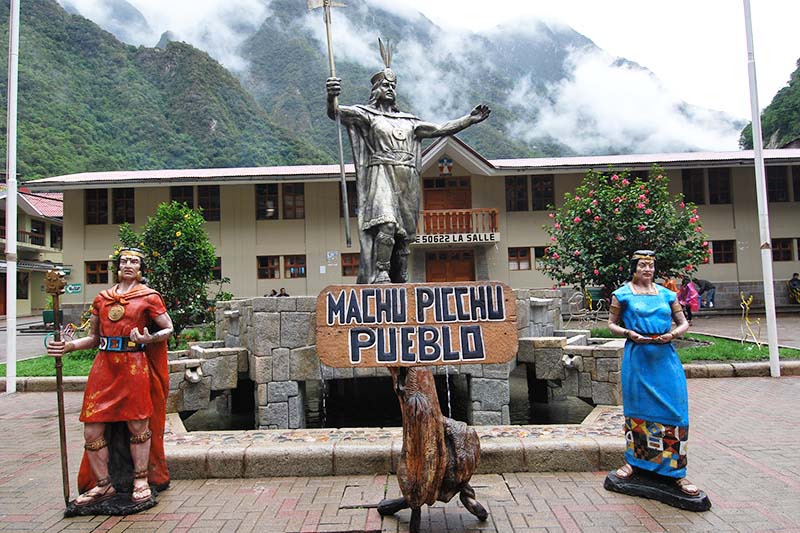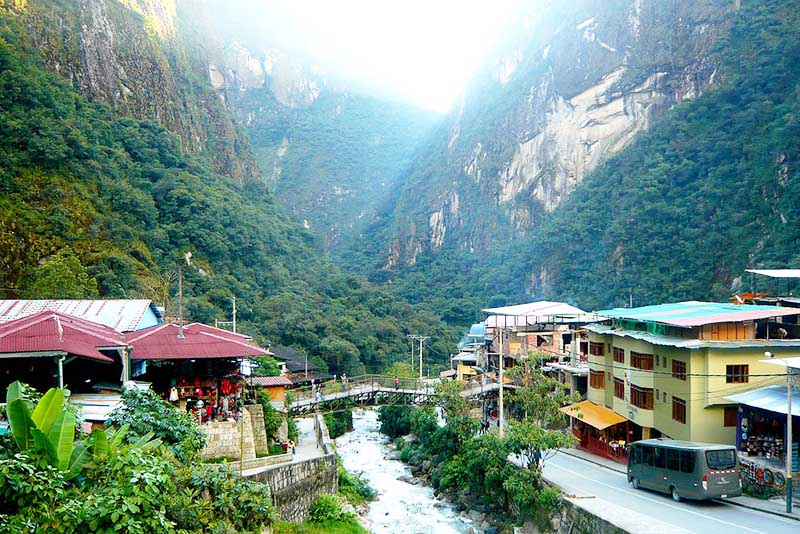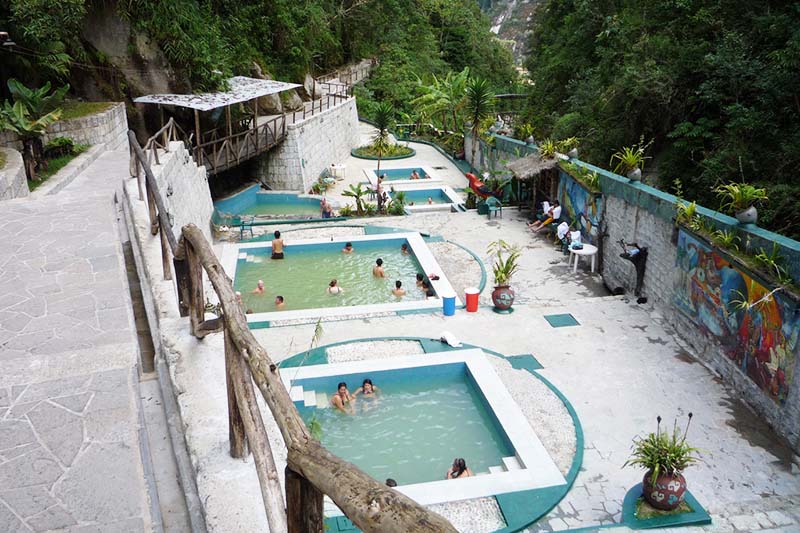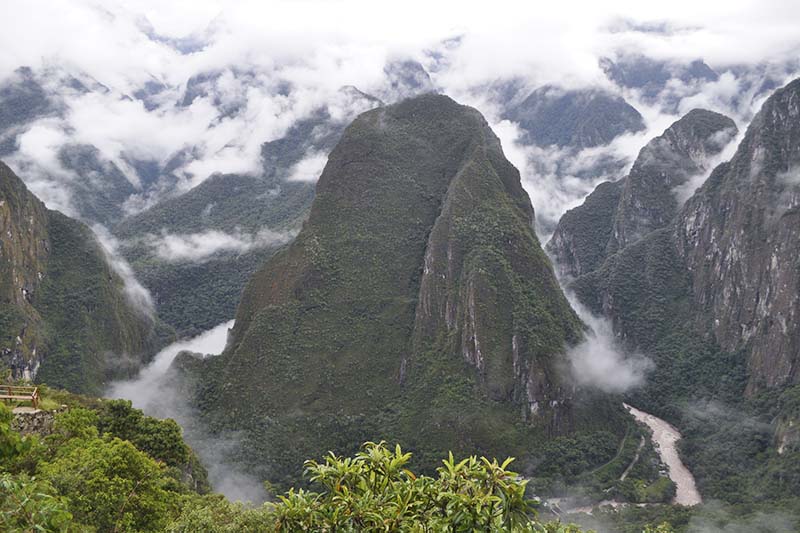Machu Picchu Pueblo / Aguas Calientes
The town of Machu Picchu is better known as Aguas Calientes; this town is the last station of the trains to Machu Picchu. It has a little more than 6,000 inhabitants, who receive about 3,000 visitors each day.

Main Square of “Machu Picchu Pueblo”
Machu Picchu Pueblo or Aguas Calientes is located between the Amazon jungle brow and the Andes mountain range; this makes the mountains where Machu Picchu and the surrounding area are built, are covered with vegetation. The Machu Picchu and Huayna Picchu mountains rise from the bottom of the valley, on one side of the Vilcanota River, on the other side of the river is the town of Aguas Calientes.
The exuberance of the location can be noticed in the scenery, with ravines and cliffs; you will notice them while ascending Machu Picchu by bus or if you decide to climb one of the Machu Picchu mountains. The valley extends for more than 40 kilometers through multiple ecosystems and is green in all directions; You can see exuberant flora and wildlife.
Where is Aguas Calientes?
Machu Picchu Pueblo or Aguas Calientes is located in the south east region of Peru, in the department of Cusco, province of Urubamba, district of Machu Picchu. It has a height of 2,040 meters above sea level, and is 110.5 kilometers from the city of Cusco.
What can be found in Aguas Calientes?
All the people who enter Machu Picchu by train will reach the town of Aguas Calientes; consider it the beginning of your visit to Machu Picchu. It is entirely dedicated to visitors to Machu Picchu. You can find restaurants, craft markets and hotels, from basic accommodations and camping areas to 5 star hotels; you will also find the buses to Machu Picchu, these cross the Hiram Bingham road, to leave it at the entrance to Machu Picchu.
Other things you can find in this town are ATMs, bank offices, pharmacies, a small health center, police station, pay phones, internet cafes, souvenir shops and the bus tickets office for Machu Picchu.
How to move in Aguas Calientes?
It is the best place to relax after the trek through Machu Picchu and the mountains. It is a town without any urban planning, there is no airport or roads, except the one that leads to the entrance to Machu Picchu; It is small, so public transport is not necessary, everything is very close to each other and can reach almost anywhere walking.
All that seems to be needed is the train station and the bus station that take visitors from the village to the entrance of Machu Picchu. It also has a small heliport, but this only serves to attend emergencies, since you cannot invade the airspace of the natural reserve of Machu Picchu; and in case you didn’t know it inside Machu Picchu are not allowed drones and other objects.
Just a few minutes away from the town (walking) you can find the thermal baths and crossing the bridge Ruins the museum of Machu Picchu site and the entrance to the mountain Putucusi; you will not need a ticket Machu Picchu to enter this mountain, at least for now.

Machu Picchu Pueblo also known as Aguas Calientes
History of the town of Aguas Calientes – Machu Picchu Pueblo
The origin of Aguas Calientes goes back to the year 1901, when a railway workers’ camp was assembled for the first time to unite the towns of Cusco and Santa Ana. The camp had the name of Maquinachayoq, was 110 km from the city of Cusco and would become the center of operations of the project.
Around this camp, were located the railroad workers, who joined the few families of farmers settled in the place, until 1920, this population was the central axis for the accommodation of workers and their equipment until the railroad was completed in 1931, and the people who settled in that place stayed.
On October 1, 1941, it is officially created as a District. The town is inhabited by approximately 6,000 residents and is the last train station to Machu Picchu. The town has grown and has a good tourist infrastructure at all levels, able to accommodate 2,500 tourists a day. That is why, in the high season, we recommend making all your reservations well in advance.
What is the weather like in Aguas Calientes?
The climate of Aguas Calientes – Machu Picchu Pueblo – is typical of the lowland forest, warm and temperate rainforest; the rainy season goes from November to March. However, it can rain at any time of the year. The average temperature during the year ranges between 8 ° C and 22 ° C.
What to see in Aguas Calientes?
The cosmopolitan town of Aguas Calientes brings together people from all cultures, nationalities and religions of the world, and there are many places where you can exchange experiences with these people.
The thermal baths of Aguas Calientes
The thermal baths of Aguas Calientes is a natural area surrounded by mountains of more than 400 meters; They are located approximately 800 meters from the town on the edge of the Vilcanota River, its waters come from the sub-soil of sulfur that emanate from the rocks at different temperatures.
Its use is thermo-medicinal, because it has natural properties and recommended chemical combinations in medical treatments such as arthritis, rheumatism or dermatological diseases; It also improves metabolism, blocks toxins and helps stress.
The water temperature ranges between 38ºC (100.4ºF) and 46ºC (114.8ºF). The hours of operation are from 5 a.m. to 8 p.m.

View of the thermal baths of Aguas Calientes
The Craft Market
It is a fair that exhibits local crafts, consists of about 220 stalls, with pedestrian access and connection to the train station and the bus station. It is open Monday through Sunday from 8 a.m to 9 p.m.
The site museum Manuel Chávez Ballón
The Manuel Chávez Ballón Site Museum is a 25-minute walk from Machu Picchu Pueblo, at the foot of the Machu Picchu Mountain, at Km 112; passing the “Ruinas” bridge that crosses the Urubamba River; The place is known as the old train station, 1.7 kilometers from the town of Aguas Calientes.
It exhibits important lithic pieces, works of goldsmithing, ceramics, bone works, construction tools, mirrors, tweezers, knives, all are samples found in the different archaeological excavations, made in Machu Picchu.
This museum has been organized in such a way that allows us to have a general view of the importance of the Inca Culture and the City of Machu Picchu. It can be visited from Monday to Saturday from 9 a.m to 4:30 p.m.
The Botanical Garden
The Botanical Garden exhibits the impressive diversity of flora and fauna that can be found in Machu Picchu; among them are the most beautiful flowers; like, the begonias, bromeliads and the most beautiful orchids in the world, diverse bushes, ferns, native trees. It is also the habitat of peculiar animals; Among the birds, there are the hummingbirds, orioles, parrots, tarangas and the “andean cock of the rock”, national symbol of the Peruvian fauna; More than 400 species of colorful butterflies, insects that wind between leaves and branches, mammals and a complex diversity of fungi of different colors and sizes.
It is open all day, but it is recommended to visit it from 6:30 a.m. to 4:30 p.m.
The Putucusi mountain
Putucusi Mountain is a mountain 2,560 meters high, on the opposite side of Machu Picchu. Its summit offers rare and impressive views of Machu Picchu and the surrounding peaks, valleys and mountains. The top is in the clouds and seems almost surreal. It is located less than 3 kilometers from Aguas Calientes, the path is surrounded by orchids and bromeliads, as well as by swarms of butterflies. It is the habitat of dozens of mammals and hundreds of species of birds, many of them endemic. The walk is challenging, includes rocky steps and vertical wooden staircases, the largest of which measures more than 30 meters.

Surreal image of the Putucusi Mountain
Museum of models and customs of Machu Picchu
Located one block from the train station, in the urbanization Las Orquídeas A-9. In it you can see the history and life of the District of Machu Picchu, models of the Inca city and variety of creation photos of the Machu Picchu district. It can be visited from Monday to Sunday from 9 a.m. to 10 p.m.
Advice from people who have been there
 By: Ronald G
By: Ronald G“You meet people from all over the world “
“In Aguas Calientes we met people from all over the world, crazy people, just like us, for being in Machu Picchu. The town is a colorful place, and quite cozy, there are no cars, just a lot of hotels, shops and restaurants, bars and many good places to have fun.“
By Ticket Machu Picchu – Last updated, February 13, 2018